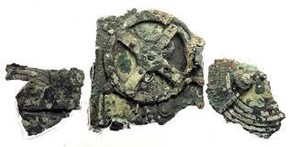By: Serena Li
The Antikythera mechanism, the world’s oldest computer, is the most sophisticated mechanism known from the ancient world. It is dated from around the 1st century B.C.
In 1901, this device, waiting at the bottom of the Mediterranean Sea for 2,000 years, was discovered among the wreckage of a trading ship that sank in the sea on the east side of the island of Antikythera. Unfortunately, when it was found, it was very beat up so scientists couldn’t discover much about it other than its purpose. It was found as one piece, then broken into three fragments which are now split into 82 fragments from cleaning and conservation.
The Antikythera could predict astronomical positions of the Sun, Moon, and other planets. It could also predict eclipses and other cycles decades before these events would happen. A knob mounted on the side controlled the device’s forward and backward movement. It didn’t track time, but instead tracked celestial motions. Turning the knob activated a complex system of gears, activating more than seven separate hands, each moving at a different speed. These hands represented the Sun, Moon, Mercury, Venus, Mars, Jupiter, and Saturn.
On the back of the machine, there were two more dial systems installed. One dial had a calendar that tracked lunar and solar eclipses. The other showed the timing of important events such as the Olympics. These dials operated based on the Metonic cycle, an advanced calendar designed to align lunar and solar calendars.This system involved four Metonic cycles adjusted by subtracting a day to get the crossway of solar and lunar time. The Babylonians had astronomical knowledge and the Greeks were able to visualize the movements of celestial bodies in gears using their knowledge in geometry.
You can see all of the fragments of this artifact at the National Archaeological Museum in Athens, Greece, with many replicas demonstrating how it looked and worked.











